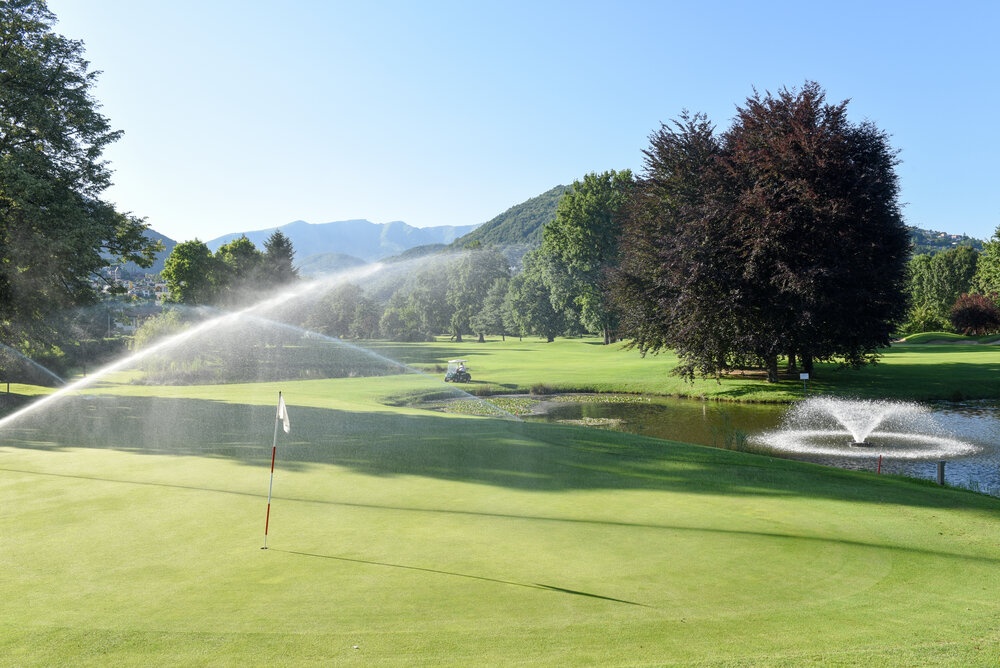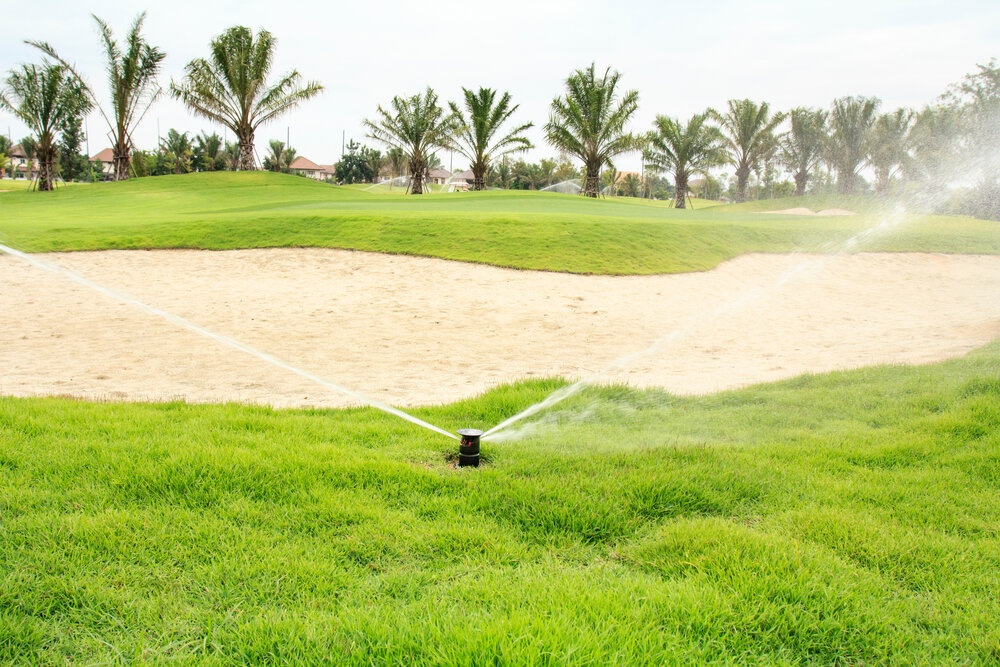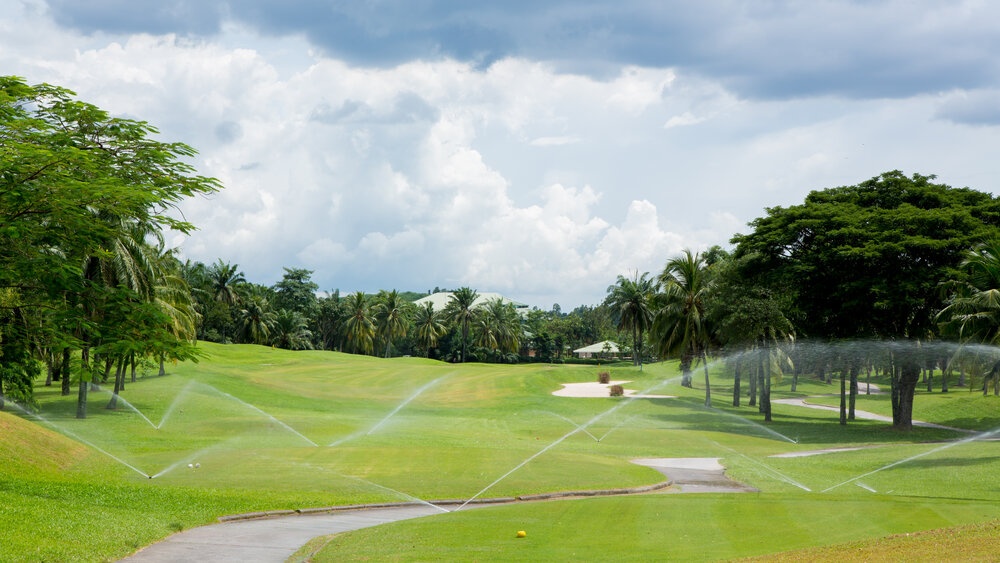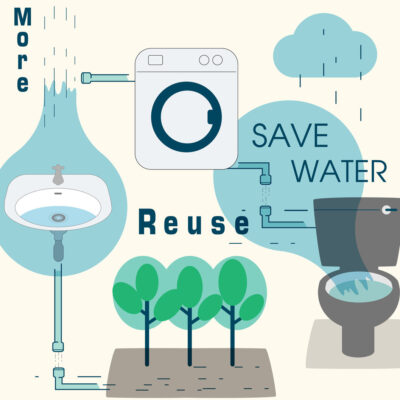Golf course irrigation is essential to ensure the various parts of the courses are kept in tip-top condition and to give players the best-golfing experience possible.
The summer months are the most demanding in terms of irrigation, especially during protracted dry spells. Of course, the irrigation requirements change throughout the year.
Natural rainfall is notoriously irregular, at least as far as golf greenkeepers are concerned. Despite the best modern forecasting techniques, it still remains uncertain to a degree as to exactly when it is going to rain and how heavy the rainfall will be. Consequently, the settings of golf course irrigation systems need to be easily manageable.
The fact of the matter is that without an efficient irrigation system, it would be virtually impossible to make sure that a golf course stays in playable condition.
What is Golf Course Irrigation?
Golf course irrigation is simply a process designed to deliver water to the turf in order to keep it alive.
The water can be taken from various sources, such as boreholes, lakes, mains water, etc. It must then be transported in a controlled manner to the target areas of the course - the fairways, greens, and approaches.
The more sophisticated the irrigation system, the more control you will be given as to how and when the irrigating waters are delivered.
The Basic Components of Golf Course Irrigation System

Basic golf course irrigation systems revolve around a set of standard products and components, including:
- A pump station
- A network of pipes
- Control valves
- Control lines
- Sprinkler heads
Let’s take a look at each element in its own right.
The Pump
The pump station for any irrigation system will be installed adjacent to the water source. When activated, the pump will draw the necessary volume of water from the source and distribute it.
The Network of Pipes
Distribution from the pump station is achieved by pumping the water through a network of sub-surface tubes and pipes. This network of pipes is sometimes referred to as arterial pipes, given that diagrammatically they look and act like a network of arteries pumping blood.
The Control Valves
The control valves manage the release of water either into the distribution lines or to different valves. Depending on the sophistication of the golf course irrigation system, they will be either manually or remotely controlled.
Where a remote system with hydraulic switches is employed, the valves are managed via dedicated, remote computer software.
The Control Lines
The control lines are laid sub-surface beside the pipes, connecting the irrigation system to the remote, dedicated irrigation software. The task of the control lines is to turn the taps of valves on and off whenever the water is being dispersed under pressure via the sprinklers.
The Sprinkler Heads
The sprinkler heads are the only things that golfers get to see. Everything else is either hidden underground or is remote.
Golf course irrigation systems are configured with rotary, pop-up sprinkler heads. It is these that deliver the right volume of water to the targeted areas throughout the golf course. The heads have a 360° turn capacity in order to facilitate effective, uniform irrigation.
The golf course irrigation systems available today all use specialised software that enables the maintenance management team to alter the settings to optimise irrigation performance.
A good irrigation system will calculate the most efficient run patterns and analyse the hydraulics of the system in order to figure out where the most pressure is required. It will then alter the routing accordingly to achieve optimisation.
Before we move away from the analysis of the components of a golf course irrigation system, a quick word about the source of the water.
The Use of Borehole Water Sourcing
Sourcing water from boreholes is a much more economical way of accessing water than taking it from the local mains water supply. Naturally, it all depends on the local topography of the course, but where possible, if boreholes can be used, the savings will mount up year on year, especially given the recent price increases in mains water.
Using boreholes for golf course irrigation systems also has the advantage of providing a larger volume and higher pressure of water than can usually be obtained from the mains supply. Borehole water is non-potable and is therefore free of chlorine and fluoride, which actually benefits grass growth and health.
If you are considering the use of borehole water, the first thing to do is to establish details about the make-up of the ground below or adjacent to the course. If your course is sat above chalk or marl formations, the water capacity of the borehole could be hundreds of cubic metres per day. If the course is sat above other types of aquifers, the capacity will be significantly less – say only three or four cubic metres per day.
A quick way to establish the possibility of using borehole water is to get in touch with the British Geological Survey people. They can provide you with a free report as to borehole water availability.
Determining When Watering Golf Courses is Necessary

Some clubs use their irrigation systems when it is not really necessary. It's poor economics. It not only increases the wear and tear on the system, but it uses more water than is needed, and water is not cheap, especially these days. Environmentally, it’s also a waste of a limited resource
To determine the right time for irrigating your golf course, you need to consider:
- The moisture content of the soil
- Ambient temperature
- The rate of evaporation
- The weather forecast
In order to gather some of the above information, the layout of your irrigation system will need to include an array of sensors. By deploying sensors, the system controller will be enabled to decide autonomously when and where irrigation is necessary. However, systems must be constantly manually monitored to ensure the right level of irrigation is delivered.
Typically, the best time to irrigate is in the morning when temperatures are generally lower, and there is less wind. If you irrigate in the afternoon, you will encourage water evaporation, especially during the warmer weather. When this happens, your turf won't receive the amount of water it needs to remain healthy.
When we talk about evaporation should really refer to “evapotranspiration,” or ET for short. The term “evapotranspiration” is the combination of two things - evaporation and transpiration.
Evaporation describes a state whereby liquid (in this case, water) changes into vapour. This happens to water on plant surfaces. The loss of water as it works its way through the soil to the plant root system and through the plant, is what is known as transpiration.
As a general rule, if you take one cubic metre of soil, the amount of moisture it contains should be around 25%. If we are talking links courses, it’s more likely to be around 15%.
Golf Course Fertigation
While golf course irrigation is a must, you should also consider “fertigation.” It is the name given to the process of injecting nutrients and fertilizer in liquid form into not just golf course irrigation systems but to farming irrigation systems too.
While irrigating grass with water alone will keep it alive, by introducing fertigation into the process as and when appropriate, you will enhance the grass’s natural colour, and strengthen its root systems.
You can buy specialist liquid fertigation products suited to the season and with different micro-nutrient and chemical compositions.
Before you decide on which fertigation product or products are needed and bearing in mind it will vary from area to area across your golf course, it’s important to take soil samples.
Golf Course Irrigation System Operation and Maintenance Quality Check
To keep your irrigation system in good working order, you should carry out regular quality checks. Here are some of the things to look out for:
- Inspect the location of the sprinklers. Take note of the irrigation coverage area, and ensure the irrigation is even and uniform.
- Check out the pumping station and the water source. If you're not getting the pressure you need, and you're not sure of the source's longevity, you might have to consider other options - boreholes, perhaps?
- Inspect any previous repairs to ensure they are still holding up. Also, keep an eye on repair costs. If they start consistently running high, it might be time to replace or upgrade your existing irrigation system.
Sustainable Golf Course Irrigation
With climate change now not only a matter of fact but a matter of extreme concern, golf clubs would do well to consider what the future holds. Only last year (2021), the UK National Audit Office warned the government that areas of southern England might expect to start running out of water in the next two decades.
Now is the time to start looking for sustainable water sources. You could be facing the reality in the near future of your irrigation system being cut off from the water mains supply. If you don’t already have access to borehole water, now is a good time to start investigating.


